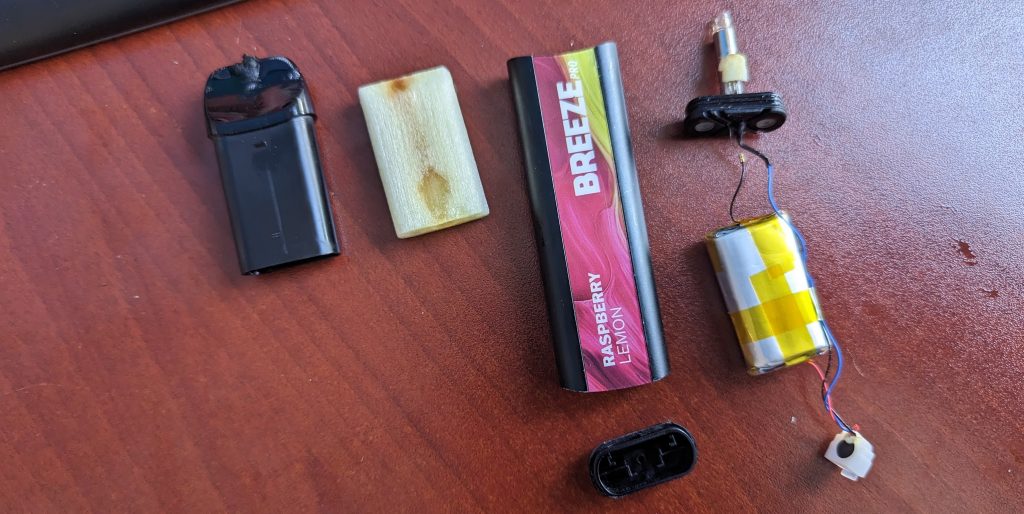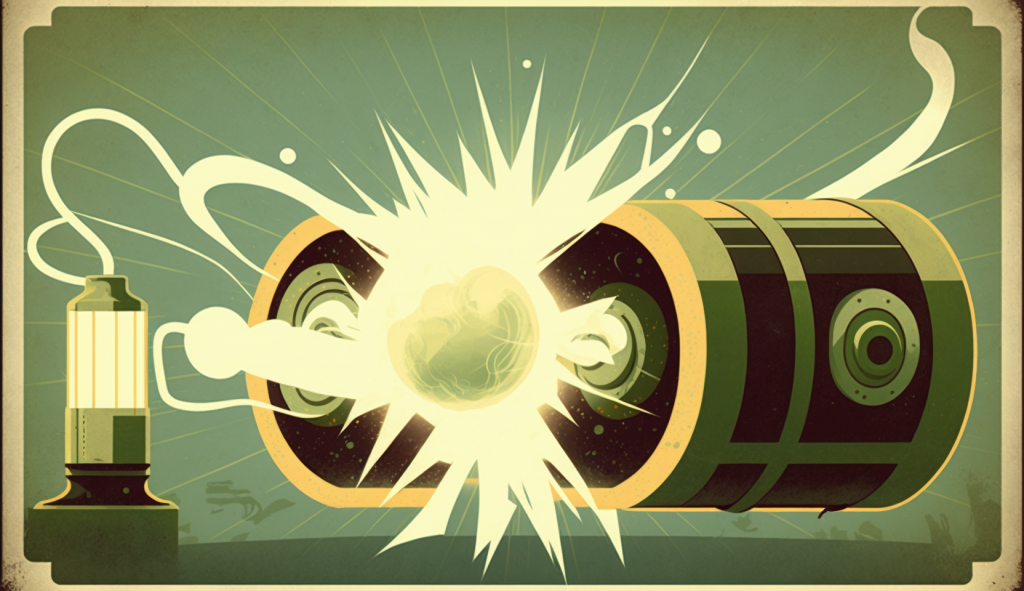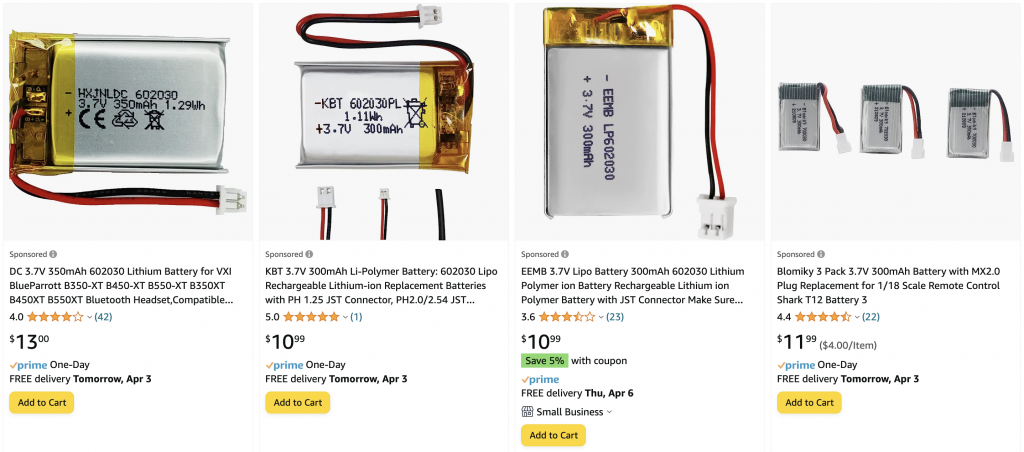Disposable Vape Pens, The Next E-Waste Nightmare
I admit that I have a few gimmicks. I also have a few friends who are smokers (cigarettes! Still, shockingly, in this day and age!). One of my gimmicks is that, whenever they pull out a cigarette or leave the room to indicate that they’re taking a smoke break, I am sure to lean in, wag a finger, and say, in a performative voice channeling the obnoxiousness of 1990s Jim Carrey: “You know, I hear those things’ll kill ya!” I am told it’s somewhere between almost endearing and thoroughly infuriating, but one of the things I haven’t been lecturing the young’uns on is vaping. I may have to start, given that disposable vape pens are introducing a new toxic thing in large amounts into– no, not kids’ lungs- municipal waste streams all over the world: lithium-ion batteries.
Let’s dive in. I mean, into the subject– not into the piles of discarded vape pens I’ve been noticing in parking lots across the great nation of Michigan.

First, What’s A Vape? I’m Not Up With The Lingo.
Disposable vape pens are, on average, pen-sized devices that feature a battery, some kind of control feature or automatic airflow sensor, and a vessel holding some sort of liquid, whether THC or nicotine. Suffice it to say that THC and nicotine work a little bit differently in vape design (we will return to this point later). In terms of ergonomics and health effects, nicotine vapes are unequivocally superior to cigarettes. Unlike cigarettes, nicotine vapes don’t leave your clothes reeking. They’re less harsh to inhale. And they are, for the most part, less harmful (with a lil asterisk– more below).
They are all the rage, whether you’re a trendy twenty-something white girl who works in marketing, a middle-aged blue-collar Black man, or, really, anyone in between. They feature not only the nicotine high, but also that sweet, sweet, artificial taste in any of dozens of flavors. Truly disgusting. And yet truly delicious.
Anyway, unlike cigarettes, vapes are less likely to be stigmatized by especially younger people, which is problematic, given the whole “you can’t sell cigarettes to kids” mandate. This is also problematic given the fact that vapes are essentially just cigarettes in a different form. Most industrially produced nicotine is chemically extracted from tobacco products anyway. The market has seen stellar growth– and, no less, out of the ashes (pun possibly intended) of the tobacco industry (RIP in one of the greatest collabs of history between 52 attorneys general and some assembly of federal judicial folk).
This article, in contrast, is about the fact that virtually every disposable vape sold in the United States today includes a lithium-ion battery. And most of them– in spite of being classified as e-waste- are thrown straight into the garbage.
Lithium, Schmithion, What About Health? Are Vapes Not As Bad As Cigarettes?
An in-depth look at the health effects, though, might make for another article, so, funny that, I wrote one.
Sidebar: Are Those Nicotine Vapes Actually Better Than Cigarettes?
Why Li-Ion Batteries Shouldn’t Be Disposed Of In The Trash
First of all, because we’re not animals. I have this conversation with people every day– people I work with, even people who share the same roof as I do- how plastic bags are the “film plastic that is explicitly not allowed to be put in the recycling bin,” or how “you aren’t supposed to just throw electronics into the trash.” I’ve written before about how appallingly premodern Michigan’s culture is around recycling– people just don’t do it here and it’s not part of the culture. Rather? Waste is part of the culture.
But the second (actual) reason is not necessarily because everybody wants to use lithium-ion batteries to electrify the world’s cars. I don’t particularly care about cars (if you’ve never read my blog before). Rather, it’s because, in spite of the fact that VMT reduction should be more important than electrification, electrification is still coming, and this is coming to the world of utility-scale energy storage, too. This means that the mining of these special minerals is going to become a huge topic in the coming years. It’s going to destabilize geopolitics and, deservedly, rile an environmental movement (no, the pundits at Fox don’t count, because they ironically didn’t care about environmental issues before electric cars).
So, we probably shouldn’t be quite as eager to toss these things in the garbage when we can recycle them. While the debate often seems to be about lithium, that’s mostly because lithium is the secret ingredient– it accounts for a relatively small percentage of the components in the actual battery. One of the problems I found when doing research for this article is that there’s a computational challenge in figuring out whether we’re talking about tons of lithium mined vs. tons of batteries produced, but it gets even more complicated when you learn that, for the most part, consumer electronics account for such a small percentage of total volume of lithium batteries that many figures for production rates completely exclude consumer electronics. That means that consumer products are off the radar of many folks doing the analysis. That doesn’t mean, though, that we shouldn’t be concerned about the e-waste littering parking lots so people can get their nicotine fix.
Beyond the metals and environmentally disastrous mining thereof, there’s another issue in that lithium-ion batteries are also filled with especially stinky solvents. Carbonate solvents, fluorinated solvents. Recycling the metals is also a tough thing because lithium-ion batteries are basically layers of metals laminated together tightly with plastic sheets, and then held together by some combination of plastic, foil, alumininum, glue, tape, string, sawdust, and whatever. Larger assemblies of batteries, often in things like eBikes, are “potted”– encased in a larger enclosure and then cemented in place with epoxy. So, that’s yet another layer of mess to handle.
Any time you’re heating something, beyond the risk of explosion, the process is inevitably going to produce toxic gases, which are going to have to be captured (complicated), chemically scrubbed (expensive), incinerated at a high temperature (expensive and with a high carbon footprint), or, most likely, some combination of all three. There are multiple recycling methods that involve solvents, biological catalysts, and electrochemical treatments.
The Full Ingredient List
Lithium-ion batteries contain quite a bit of stuff. Lithium, the cathode of the battery, is between around 5 and 20% of the battery by weight. It’s usually some combination of compounds, like lithium cobalt oxide (LiCoO2), lithium nickel cobalt aluminum oxide (NCA), lithium nickel manganese cobalt oxide (NMC), or lithium iron phosphate (LiFePO4). Then the anode might be graphite or silicon (5-15% by weight), the electrolyte contains organic solvents with lithium salts (incl. LiPF6, LiBF4, or LiClO4, 5-15% weight by volume), the separator (the layers of plastic) are 10-20% by weight, and the case might be between 5 and 20% of the weight.
The solvents are stinky and gross and toxic. The rest of these are just relatively rare metals whose production is resource-intensive.
It’s hard to know what they are, because battery technology is considered the holy grail of electrification, and companies guard these trade secrets. In my youth, for example, everything was powered by alkaline batteries. Lithium-ion won the battery format war over competitors like NiMH or NiCad. There will be more battery types, of course. We’re just living in the golden age of lithium-ion in the interim, and, while we don’t know exactly what all is in them, suffice it to say that there are a number of rare and toxic ingredients.
“It’s Just A Little Pen, Michael! What Could It Weigh, 3000 Grams?”
American conservatives, who suddenly would like you to believe that they actually care about environmental conservation, are sounding the alarm about the dangers of mining how many rare earth metals will be required to fuel this crazy electrification revolution that UN Agenda 21 and George Sorrows And Her E-mails [sic] are promoting. Unlike my colleague Angie Schmitt, however, I will not concede give the point to Republicans here, but rather argue that a stopped clock is right twice a day, and this stopped clock correctly points out that the one-for-one alternative to the current paradigm requires a whole lot of resource extraction. (Don’t be fooled, though– they still don’t care about the environment. If they did, they wouldn’t have made the CAFE standards a joke, or they wouldn’t have laughed off the idea of a carbon tax, or, they might have saved taxpayers some money by ending the hundreds of billions of dollars in subsidies to climate arson. Anyway!).
How much lithium, though? And of that, how much accounts for these disposable vape pens?
It’s hard to say, because data are kinda hard to come by. This is partially a question of how the market is segmented. (Believe me, I tried!).

…billions of pens?
It’s also complicated, because when we talk about “lithium-ion batteries,” as mentioned above, there are many metals and non-metals that comprise the battery (and, again, none of them should be discarded in the trash). The most recent year I was able to find real data for showed a 2019 peak of as many as 22 million units of disposable vape pens sold in a single four-week period. That was a peak, but we also know that the sales numbers have skyrocketed since 2019. If we use that peak, that works out to around 2.6 billion vapes sold in the average year. Another estimate suggests that the market will be worth $40 billion in 2023, and yet another suggested that there may well be tens of millions of regular vapers in this great nation in 2023. A $40 billion market is probably around– wait for it- 2.6 billion vapes sold in the average year, if we assume a price point of $14.99 for a Breeze pen or similar. Wild, how numbers work.
Napkin math, though? Probably something to the order of tens of thousands of Tesla batteries. A Tesla battery weighs around 0.6 tons, and 2.7 billion vape pens works out to around 14,000 tons of batteries. A Tesla battery is the better part of one ton.

Ultimately, the novelty of vapes means we’re kind of traversing a regulatory no-man’s-land at the moment until the federal government can get organized and figure out what it’s trying to do.
Is There A Less Irresponsible Way For Me To Get My Fix?
Fortunately for the eco-conscious, there are such things as refillable vapes, whether we’re talking about nicotine or THC. But never the twain shall meet, it seems– if not because of different chemistry and physics, then because of incompatible market logistics. Nicotine products are heavily regulated by federal and state rules, while ∆9-THC products exist in that– ahem- hazy area of “federal illegality but we’re not going to enforce it” vs. state licensing and regulatory law. This is a long way of saying that you generally can’t buy nicotine products in the same physical venue that you buy ∆9-THC products.
There are some regulatory grey areas, of course, including ∆8-THC and ∆10-THC products, which can still get you high, but are sometimes unregulated because most laws are written to explain the 9-position of the double-bond on the benzene ring in the THC molecule (it’s not clear that any of the hundreds of half-dead, ancient white men in the federal government railing against the sins of the devil’s lettuce actually understands this).
Alkaline Batteries. Sure, someone could figure out a way to make a disposable vape using alkaline batteries, which, these days, can be discarded into municipal waste (even though you should still try and recycle them– they just don’t contain mercury like they did decades ago, which was a way worse thing to be dumping in the garbage). The problem with this is that alkaline batteries have a lower energy density than Li-ion, which means that these vapes would be much heavier and therefore less ergonomic to the carry-weight-obsessed consumer (and the shipping-weight-obsessed retailer and retail logistics purveyor).
Cartridges are an option for rechargeable vape pens. In contrast to disposables, 510 cartridges are more or less the only standard for vape products. The problem is that these are mostly THC and CBD products, since nicotine behaves somewhat differently in liquid form and . Refillable nicotine vape products do exist, though, although the market seems to be evolving more slowly than the cannabis market. However, the industry standard 510 (5mm thread length, 10mm diameter) is fairly ubiquitous. I’ve personally had horrific luck with the products themselves, which are designed about as cheaply as the disposable ones. But there is hope, and there are higher-end products, still. Anyway, the big thing with the carts is that they are just glass, steel, and some plastic or silicone.
That’s something I feel somewhat less bad about tossing into the garbage than, you know, a package of toxic solvents and rare metals.

Lithium-Ion Recycling Initiatives?
In an ideal world, there would be some sort of local lithium-ion battery recycling aggregation system. You’d take your batteries to the local whatever, or there would be a bin at your local gas station, or what have you. These would be picked up periodically, and would be taken to a larger facility, which would be receiving many dropoffs from similar locations. Eventually, these would all be trucked off again to a state-of-the-art recycling facility, tucked away in a not-residential neighborhood, and the batteries would be pyrometallurged, for lack of a better term, down into their back ingredients.
It’s probably worth trying, right? I mean, it might cost some money, but it’s probably going to cost a lot of money to scrub fluorinated carbonated whatever-ated solvents out of our water supply, right?
Currently, the distribution and logistics of lithium-ion battery recycling is elusive unless you go out of your way to do the research. There are certainly not recycling bins for disposable vape pens at every smoke shop. Maybe there should be.
This article has a counterpart, which looks at the relative safety of disposable vape products and e-cigarettes in comparison with, shall we say, acoustic cigarettes. Like what you’re reading? Consider becoming a supporter today. Don’t like it? Consider contributing to the cause, and if you pay me enough money, I might just stop writing altogether!


